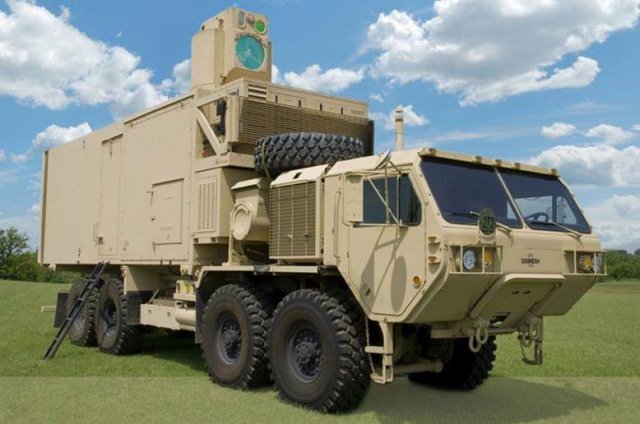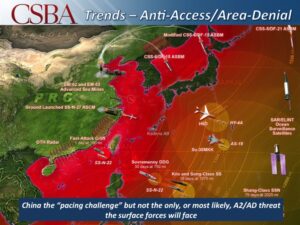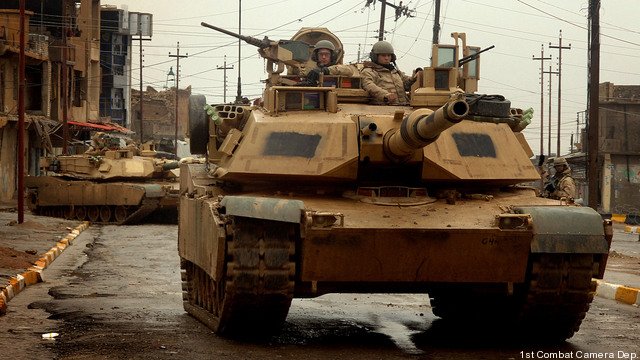Laser On A Truck: Army’s Role In Offset Strategy
Posted on

Army HEL (High Energy Laser) Mobile Demonstrator
CAPITOL HILL: Where do ground forces fit in the Pentagon’s new offset strategy? The answer may be an intriguing mix of old-fashioned armored forces, mobile missile launchers, and lasers on trucks.
While Defense Secretary Chuck Hagel’s remarks formally launching “offset” were frustratingly vague, we’ve heard plenty from other officials and outside thinkers about how the Pentagon must pursue breakthrough technologies to keep ahead of rapidly advancing adversaries in the air, sea, space, and cyberspace. Generally absent from the discussion: land forces.
 The main nightmare scenario driving the offset strategy is a war with China in the Western Pacific. Even the return of the Russian bear has raised more concerns about advanced anti-aircraft missiles and deniable incursions of “Little Green Men” than about a Soviet-style Red Army onslaught. The specific problem that the offset strategy must focus on, most experts say, is defeating Chinese, Russian, or Iranian “anti-access/area denial” (A2/AD) forces: long-range precision-guided missiles, supplemented by submarines, advanced fighters, and cyber and space attacks, that can deny US forces access to an area in crisis — e.g. Taiwan or the Baltic States. Deploying conventional ground troops once you get access isn’t much discussed. It’s natural for the already-anxious Army to worry it might be left out of the offset strategy and suffer for it in the budget wars.
The main nightmare scenario driving the offset strategy is a war with China in the Western Pacific. Even the return of the Russian bear has raised more concerns about advanced anti-aircraft missiles and deniable incursions of “Little Green Men” than about a Soviet-style Red Army onslaught. The specific problem that the offset strategy must focus on, most experts say, is defeating Chinese, Russian, or Iranian “anti-access/area denial” (A2/AD) forces: long-range precision-guided missiles, supplemented by submarines, advanced fighters, and cyber and space attacks, that can deny US forces access to an area in crisis — e.g. Taiwan or the Baltic States. Deploying conventional ground troops once you get access isn’t much discussed. It’s natural for the already-anxious Army to worry it might be left out of the offset strategy and suffer for it in the budget wars.
So what can the Army do for the offset strategy, and what can offset do for the Army? That’s the question I posed to Center for Strategic and Budgetary Assessments experts Robert Martinage, a former under secretary of the Navy who’s also worked on long-range bombers, and Andrew Krepinevich, a retired Army officer and disciple of the legendary Andy Marshall.
 The two men were on Capitol Hill to tout Martinage’s detailed vision of what the offset strategy should be. The chairman of the House Seapower and Projection Forces subcommittee, offset enthusiast Rep. Randy Forbes, said “I’ve not only read it, it’s sitting on my desk, it’s all marked up with squiggly lines and yellow highlights.” That’s understandable because Martinage advocates mainly for programs under Forbes’ jurisdiction, such as the new long-range strike bomber, a high-performance version of the Navy UCLASS drone, and submarines, both manned and unmanned.
The two men were on Capitol Hill to tout Martinage’s detailed vision of what the offset strategy should be. The chairman of the House Seapower and Projection Forces subcommittee, offset enthusiast Rep. Randy Forbes, said “I’ve not only read it, it’s sitting on my desk, it’s all marked up with squiggly lines and yellow highlights.” That’s understandable because Martinage advocates mainly for programs under Forbes’ jurisdiction, such as the new long-range strike bomber, a high-performance version of the Navy UCLASS drone, and submarines, both manned and unmanned.
But Martinage has suggestions for the Army, too. “General purpose, conventional ground forces have a potential role to play,” he told me after the event, “but one of the key challenges is going to be inserting and sustaining them.” Anti-access/area denial systems that can threaten stealth jets, aircraft carriers, and airbases will pose an even bigger problem for the transport planes, cargo ships, and ports required to deploy and supply a sizable ground force. So if you need ground forces in the war zone — to keep Russia from overrunning the Baltic States, for example — you have two choices. You can wait until air- and seapower have ground down the enemy A2/AD and it’s safe to deploy ground troops — or you can deploy them before the shooting starts.

Robert Martinage
“Inserting and sustaining large numbers of ground forces once the balloon goes up is going to be challenging, [so] in potentially mid to high-level threat environments, they’re going to need to be forward based,” Martinage told me. “It’s not unlike where we were in the Cold War, [when] a lot of the ground forces was pre-deployed in Central Europe. So this could be a little bit of back to the future.”
The difference is what it will take to keep those ground troops alive. Any adversary with the long-range precision missiles that make A2/AD possible in the first place can also field short-range smart weapons — what CSBA calls “guided rockets, artillery, and mortars” (G-RAM). A big Forward Operating Base or large formation of ground troops becomes a great big bull’s-eye for such weapons.
Part of the answer is to spread out — “disaggregate” in military parlance — into many smaller, independent units that keep on the move, Martinage said. That puts a premium on robust, jamming-resistant communications. But it’s also important to defend against the incoming precision weapons. Such weapons can be jammed, and indeed the Army’s reinvesting in the long-neglected art of electronic warfare. Then there is the new technology of directed energy — specifically, lasers.
“Short-range directed energy defenses start looking pretty compelling… a laser on a truck,” Martinage said. “If you don’t have laser on a truck, I think you’ve going to be bedeviled by those precision-guided short-range weapons.”
Future ground forces can also add offensive firepower to the offset strategy. The Army already touts its missile defense systems, like the Patriot and THAAD, many of which can also kill enemy aircraft. But Martinage and Krepinevich both want the service to get into the business of striking surface targets, firing ground-based cruise missiles at both ground targets and ships.

Andrew Krepinevich
“I think rocket artillery in its various forms is going to be the big winner for the ground services,” Krepinevich told me: “air defense, missile defense, coastal artillery — which Hagel talked about at the AUSA conference in the form of land-based anti-ship cruise missiles [–] and then strike.”
Building an Army offensive missile arsenal wouldn’t merely duplicate what the Air Force and Navy already have, because ground-based missiles are different. While they lack strategic mobility — you probably need to deploy them before the crisis — they arguably have superior survivability. Just think of how much trouble the US had hunting down mobile SCUD launchers in the Iraqi desert in 1991.
A single mobile missile launcher is much easier to hide and much less painful to lose than a warship or an airbase full of bombers. “They can disperse, they can harden, they can be mobile,” Krepinevich told me, “as opposed to say concentrating air power at a major airbase or naval power on an aircraft carrier, which is a lot of eggs in very few baskets.”
In essence, an Army force of ground-based cruise missiles would create an American equivalent to China’s Second Artillery, our own anti-access/area denial force. Conversely, sometimes the best way to shrink an enemy’s A2/AD zone might be to invade it on the ground.
If Iran started launching long-range weapons across the Persian Gulf against Saudi Arabian oil infrastructure, for example, the stability of the global economy might require US forces to occupy potential launch sites, Krepinevich said, creating a “buffer zone” too broad for the Iranian missiles to cross and still hit their targets. If a future adversary relied on mobile launchers — especially with nuclear weapons — we might have reasonable doubts about our ability to destroy them all from the air, in which case, he said, “you’d have to occupy the area and secure it.”
Missions like that mean there is still a place for the heavily armed and armored Army brigade combat teams, Krepinevich told me. In fact, blitzkrieg-style warfare combining tanks, troops, and air support remains an American “core competency” we shouldn’t give up. “We are the best in the world at combined-arms mechanized air-land operations,” Krepinevich said. “We do it better than anybody else. And for that reason we don’t see people trying to challenge us that way — which is a good thing.”

Subscribe to our newsletter
Promotions, new products and sales. Directly to your inbox.
